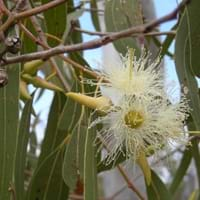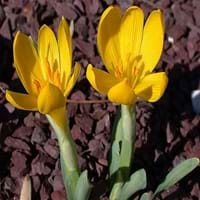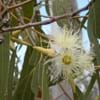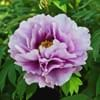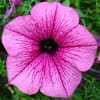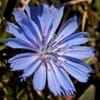Life Span
Perennial
Perennial
Type
Shrubs, Trees
Bulb or Corm or Tuber
Origin
Australia
Southern Europe, Mediterranean, Turkey, Iran, Central Asia, Western Asia
Types
Eucalyptus absita, Eucalyptus acies, Eucalyptus calycogona
NA
Number of Varieties
Not Available
Habitat
River side
countryside, Rural areas
USDA Hardiness Zone
9-10
Not Available
AHS Heat Zone
10-1
Not Available
Sunset Zone
5, 6, 8, 9, 10, 11, 12, 13, 14, 15, 16, 17, 18, 19, 20, 21, 22, 23, 24
21,22
Habit
Oval or Rounded
Clump-Forming
Flower Color
Pink, Red, White
White, Yellow
Flower Color Modifier
Not Available
Bicolor
Fruit Color
Yellow Brown
Not Available
Leaf Color in Spring
Dark Green
Green, Gray Green
Leaf Color in Summer
Gray Green
Light Green
Leaf Color in Fall
Gray Green
Several shades of Green
Leaf Color in Winter
Gray Green
Light Green
Leaf Shape
Oval
Strap shaped
Plant Season
Winter
Spring, Fall, Winter
Sunlight
Full Sun
Full Sun
Type of Soil
Well drained
Loam, Sand
The pH of Soil
Slightly Alkaline
Neutral, Alkaline
Soil Drainage
Well drained
Well drained
Bloom Time
Early Summer, Spring
Early Spring, Late Summer, Early Fall, Fall, Late Winter
Tolerances
Drought
Drought
Where to Plant?
Ground
Container, Ground, Pot
How to Plant?
Stem Planting
By dividing rhizomes, tubers, Corms or bulbs, Offsets
Plant Maintenance
Medium
Medium
Watering Requirements
Requires regular watering, Requires watering in the growing season, Use and maintain water-efficient soaker hoses, Water Deeply, Water twice a day in the initial period
Average Water Needs, Do Not over Water, Requires regular watering
In Summer
Lots of watering
Lots of watering
In Spring
Moderate
Moderate
In Winter
Average Water
Average Water
Soil pH
Slightly Alkaline
Neutral, Alkaline
Soil Type
Well drained
Loam, Sand
Soil Drainage Capacity
Well drained
Well drained
Sun Exposure
Full Sun
Full Sun
Pruning
Prune for shortening long shoots, Prune if you want to improve plant shape, Prune ocassionally, Remove dead or diseased plant parts
Remove damaged leaves, Remove dead branches, Remove dead leaves
Fertilizers
All-Purpose Liquid Fertilizer
All-Purpose Liquid Fertilizer
Pests and Diseases
Canker, head rot, Mealybugs, Root rot
Cutworms
Plant Tolerance
Drought
Drought
Flower Petal Number
Single
Single
Fragrant Bark/Stem
Yes
No
Foliage Texture
Medium
Fine
Foliage Sheen
Matte
Matte
Attracts
Birds
Cutworms, Flies
Allergy
Itchiness, Pain and fatigue, Respiratory problems
poisonous if ingested
Aesthetic Uses
Not Used For Aesthetic Purpose
Bonsai, Bouquets, Showy Purposes
Beauty Benefits
Not Available
Not Available
Environmental Uses
Air purification
Air purification
Medicinal Uses
Burns, Cough, Fever, Joint pain, Pulmonary tuberculosis, Upset stomach
No Medicinal Use
Part of Plant Used
Leaves
Flowers
Other Uses
Oil is used as an industrial solvent, Oil is used in mosquito repellents, Used in paper industry
Used as Ornamental plant
Used As Indoor Plant
No
No
Used As Outdoor Plant
Yes
Yes
Garden Design
Not Available
Container, Cutflower, Lawns and Turf, Mixed Border, Rock Garden / Wall, Wildflower
Botanical Name
Eucalyptus
STERNBERGIA
Common Name
Eucalyptus
Sternbergia
In Hindi
नीलगिरी
Sternbergia
In German
Eukalyptus
Sternbergia
In French
Eucalyptus
Sternbergia
In Spanish
Eucalipto
Sternbergia
In Greek
ευκάλυπτος
Sternbergia
In Portuguese
Eucalipto
Sternbergia
In Polish
Eukaliptus
Sternbergia
In Latin
Eucalyptus
Sternbergia
Phylum
Magnoliophyta
Tracheophyta
Class
Magnoliopsida
Magnoliopsida
Order
Myrtales
Asparagales
Family
Myrtaceae
Amaryllidaceae
Genus
Eucalyptus
Sternbergia
Clade
Not Available
Angiosperms, Monocots
Tribe
Eucalypteae
Not Available
Subfamily
Myrtoideae
Amaryllidoideae
Properties of Eucalyptus and Sternbergia Lutea
Wondering what are the properties of Eucalyptus and Sternbergia Lutea? We provide you with everything About Eucalyptus and Sternbergia Lutea. Eucalyptus doesn't have thorns and Sternbergia Lutea doesn't have thorns. Also Eucalyptus does not have fragrant flowers. Eucalyptus has allergic reactions like Itchiness, Pain and fatigue and Respiratory problems and Sternbergia Lutea has allergic reactions like Itchiness, Pain and fatigue and Respiratory problems. Compare all the properties and characteristics of these two plants. Find out which of these plant can be used as indoor plant. If you are interested to decorate your house and garden, find out aesthetic uses, compare them and select the plant which will beautify your surrounding. Along with beautification, try comparing medicinal and edible uses of Eucalyptus and Sternbergia Lutea and you can choose the plant having best and most benefits.
Season and Care of Eucalyptus and Sternbergia Lutea
Season and care of Eucalyptus and Sternbergia Lutea is important to know. While considering everything about Eucalyptus and Sternbergia Lutea Care, growing season is an essential factor. Eucalyptus season is Winter and Sternbergia Lutea season is Winter. The type of soil for Eucalyptus is Well drained and for Sternbergia Lutea is Loam, Sand while the PH of soil for Eucalyptus is Slightly Alkaline and for Sternbergia Lutea is Neutral, Alkaline.
Eucalyptus and Sternbergia Lutea Physical Information
Eucalyptus and Sternbergia Lutea physical information is very important for comparison. Eucalyptus height is 2.50 cm and width 32.81 cm whereas Sternbergia Lutea height is 10.20 cm and width 7.60 cm. The color specification of Eucalyptus and Sternbergia Lutea are as follows:
Eucalyptus flower color: Pink, Red and White
Eucalyptus leaf color: Dark Green
Sternbergia Lutea flower color: White and Yellow
- Sternbergia Lutea leaf color: Green and Gray Green
Care of Eucalyptus and Sternbergia Lutea
Care of Eucalyptus and Sternbergia Lutea include pruning, fertilizers, watering etc. Eucalyptus pruning is done Prune for shortening long shoots, Prune if you want to improve plant shape, Prune ocassionally and Remove dead or diseased plant parts and Sternbergia Lutea pruning is done Remove damaged leaves, Remove dead branches and Remove dead leaves. In summer Eucalyptus needs Lots of watering and in winter, it needs Average Water. Whereas, in summer Sternbergia Lutea needs Lots of watering and in winter, it needs Average Water.
